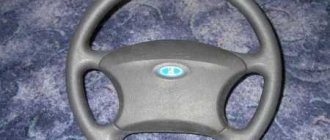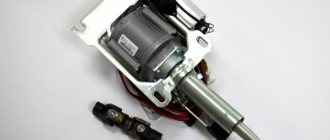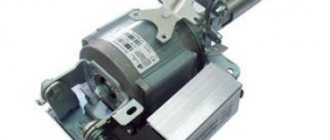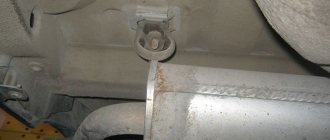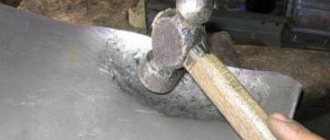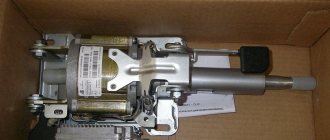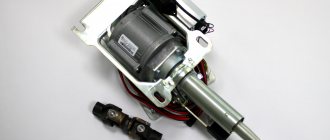| Kalina's electric power steering (EPS) is removed along with the steering column for replacement, repair, or when dismantling the dashboard. It is recommended to perform installation with an assistant. |
Required tools: Phillips and flat-head screwdrivers, high head “13”. Disconnect the negative terminal of the battery and align the car's wheels straight ahead.
Repair of electric power steering on Kalina. Signs of breakdown and repair
Electric power steering is a problem area for the Lada Kalina.
Surely this is due to the fact that the domestic auto industry has only recently become acquainted with the ESD. Avtovaz has not yet learned how to make good steering systems. Therefore, repairing electric power steering on Kalina remains a common practice. But it is best done by specialists. Amateurism will be inappropriate here - it can only aggravate the situation. The steering system is an important component, the serviceability of which determines the efficiency of driving and, of course, safety.
Repairing the electric power steering on Kalina is a responsible job that requires certain knowledge in the field of power steering. And since a minimum number of car enthusiasts have such knowledge, mostly when problems arise, drivers go to a service station, which is fundamentally correct.
How to tighten the electric power steering rack?
The appearance of a knocking sound in the operation of the electric power steering is associated with the need to tighten the steering rack.
How to do it right:
- First you need to disconnect the battery; to do this, disconnect the terminals from it. Unscrew the battery mount; to do this, you need to unscrew two more nuts located at the edges. After this, the battery is removed and put aside.
- Then you need to lift the plastic stand, there are four more screws under it, they can also be unscrewed.
- Having done this, it is necessary to move this stand forward until the platform is disconnected from the air filter housing retainer pad. After this, the trim can be moved back, this will provide freer access to the rail itself.
- At the next stage, you will need to crawl your hand under the rail. Directly below it, as shown in the photo, there is a rubberized cap; it will need to be removed, this will allow the key to access the adjusting nut.
- To perform adjustment work, you will need a special wrench to tighten the rack; without it, the adjustment procedure will not be possible. Using this wrench, you need to crawl under the car rail to install the tool in the required hole.
- When adjusting, be careful not to overtighten the rack. If its tightening is very strong, then when cornering the rack will bite, and this, in turn, may affect the safety of movement. The angle of adjustment is always different, it depends on how much the nut is loose, but usually when performing such work the nut is tightened by approximately 30 degrees. This should be enough to get everything right. After the adjustment is completed, it will be necessary to check that this task was performed correctly. That is, you will need to make sure that the steering wheel turns normally to any position all the way and there is no knocking. If the knock remains, then the adjustment continues.
Photo gallery “Adjusting the steering rack”
1. Slide the stand and detach it.
2. In this place under the rail there is an adjusting washer.
3. Adjustment is made with a special key.
4. Location of the adjusting nut.
How to determine the malfunction?
Despite the fact that repairing the EUR requires contacting a car service, you can detect the first symptoms of a malfunction yourself
.
Viburnums on the front panel have a special yellow indicator, which, in the event of a breakdown of the electric amplifier, lights up and reports an error in the system. If it lights up, it means you have another reason to visit the nearest auto repair shop. But it’s immediately worth noting that the yellow indicator does not indicate a critical malfunction, but only signals the occurrence of a problem that allows you to drive the car, but without the participation of the ESD.
If the electric power steering has completely failed, it is better to stop immediately and pull out its fuses.
. In Kalina they are located on the left side of the steering wheel. Theoretically, in case of malfunctions, the EUR should turn off on its own. However, it doesn’t happen once at a time. Therefore, to be sure, it is still worth taking care of the fuses.
Possible malfunctions and their causes
The main problem that causes damage to the electric power steering is a malfunction of the speed sensor.
The EUR installed on Kalina does not work with a constant force applied to the steering rack. The amplifier begins to operate at full strength only when the car is moving at low speed or is at rest. When accelerating, the power steering forces on the steering rack decrease. That is, the lower the speed, the more the power steering starts to work.
The naturally described malfunction can only be detected when the car is standing still or moving at low speed
.
This failure can only be corrected by completely replacing the speed sensor. Moreover, here it is not necessary to go to the service. You can replace everything yourself.
The second malfunction may be hidden in the EUR itself. Basically, it consists of self-disabling the electric power steering due to the fact that it has not passed self-test. That is, the device turns off automatically so as not to interfere with the driver when driving the car.
This kind of malfunction guarantees a trip to the service station and will require you to spend a lot of money.
What is better power steering or power steering?
The times when the driver was forced to turn the steering wheel with enormous effort even in a passenger car are long gone.
Now every more or less high-quality car is equipped with power steering. But drivers often don’t know what kind of amplifier their car has and what advantages and disadvantages it has. The car may have hydraulic or electric power steering, power steering or power steering, respectively. The first type of amplifier is powered by a special pump, which is driven by an engine and maintains operating pressure in the system. As soon as the driver begins to turn the steering wheel, a special hydraulic drive begins to help him in this. When the steering wheel is in the zero position, the system does not press anywhere and the steering wheel is at “zero” without any problems.
An electric booster is an ordinary electric motor that is located on the steering shaft and, according to automatic signals, turns the entire shaft in one direction or another. Structurally, power steering and electric power steering are completely different mechanisms, but they have the same function, so many drivers even think about what type of amplifier is on their car.
Meanwhile, the systems differ both in the nature of driver assistance and in maintainability. Power steering is a more powerful unit that is well suited for powerful SUVs and trucks. A more complex device makes the power steering a little less reliable, but in the event of a breakdown, repairing the power steering pump will cost significantly less than in the case of a breakdown of the power steering pump.
Electric power steering is more compact and cheaper, but sometimes it does not have enough power, and in the event of a breakdown, it is necessary to completely change the power steering assembly, which is more expensive than replacing any component of the power steering.
From the driver's point of view, the EUR is a more responsive system; it instantly responds to the slightest driver actions. At the same time, the electrical system can be individually configured both on individual models and its operation can be adjusted to a specific driver. In power steering, you can’t expect this, unless you are ready to modify the unit yourself.
By the way, only ESD is installed on unmanned vehicles, so in the future this system will have an absolute advantage in the market. But power steering can provide the driver with more sensitive and “natural” feedback; it also significantly compensates for vibrations and shocks from a bad road; it also does not mind harsh operating conditions. But the EUR can fail at the most inopportune moment.
Source
Additional reasons
Troubles in the operation of the electric power steering can be caused by:
- voltage drop due to possible circuit breaks due to wiring faults;
- exceeding the internal combustion engine speed;
- lack of speed sensor information.
In general, it is clear that there are not so many reasons why the ESD fails. Some of them are critical, some are not. But in any case, you need to take care of promptly eliminating the problem.
Today it is difficult to find reliable electrical circuits for an amplifier from a domestic car. Such information is mainly available only in services, and no one will share it with you. Therefore, repair of the electric power steering on Kalina is possible only within the walls of the service station
, since amateurism can be expensive. Here it is better not to take risks, not to be stingy, but to trust competent specialists.
Signs of problems with the EUR
The main sign of a problem with the electric power steering is the activation of an indicator on the instrument panel; the indicator looks like a steering wheel with an exclamation mark. Depending on the situation, the EUR turns off automatically, but if this does not happen, then this can be done manually to prevent accidental non-standard operation and the occurrence of a critical situation. To turn it off, remove the fuse located to the left of the steering wheel.
Automatic shutdown of the electric steering system is possible in the following cases:
- Reducing the network voltage below the permissible rating
- No signal from the speed sensor
- Exceeding the engine speed above normal
The latter causes are caused by faults in the sensor system or damaged cables and can be easily resolved by replacing the sensors or restoring the circuits.
Causes of failure of the electric power steering on the Lada Kalina
For the first time, the Russian auto industry installed electric power steering on Kalina. At the first stages, it worked extremely unstably, up to a complete shutdown. Later, they tried to eliminate the shortcomings, but the EUR remained a weak link and periodically fails, as evidenced by the exclamation mark on the panel. This is evidenced by the feeling of a heavy steering wheel, and turning with one hand becomes difficult.
The principle of operation of the electric booster is to reduce the force that needs to be applied when turning the steering wheel. The Kalina electric power steering control unit uses sensors to calculate the operation of the electric motor at the current speed and torque. Thereby giving a signal of the effort with which the driver needs to be helped when turning. After all, it does not work constantly and needs adjustment, which is carried out by the block.
Pros and cons of electric booster?
Advantages of EUR:
- Compact mechanism
. The device itself is installed on the steering shaft, thereby taking up no space under the hood. - Easy to maintain
. The electric booster does not require constant monitoring of the fluid level. - Easily customizable.
- Economical
. The electric motor only turns on when the steering wheel is turned.
Disadvantages of EUR:
- During heavy operation, the electric amplifier overheats. For example, on a dirt road after rain.
- Low power. The reason for this was not a powerful electric generator.
Don't forget that power steering of any type can also be dangerous.
Reasons for shutdown
The main reason lies in the electric power steering. When ignited, the system performs a self-diagnosis and if the mechanism does not pass it, a signal is turned on indicating a malfunction. The color of the signal indicates the degree of danger. The light turns red, the problem needs to be fixed urgently. If the color is yellow, the vehicle can be operated, but safety precautions should be taken. There may be several reasons why the electric power steering on Kalina does not work:
- speed sensor malfunction;
- torque sensor malfunction;
- speed exceeds 60 km/h;
- engine speed is less than 400 per minute;
- failure in the control unit;
- poorly soldered contacts;
- insufficient tension.
Software shutdown
- The electric power steering on Kalina turns off after 60 km/h. Therefore, keep this point in mind; it is set in the system unit and is not a breakdown. The Priora's electric power steering is switched off at a speed of 110 km/h.
- Also, the EUR does not work at low engine speeds. If the value is less than 400 rpm, it is not active.
This is software planned inactivity. It is needed to give information to the steering wheel at high speed and reduce wear of the mechanism.
Electrical booster malfunctions
In the event that it is impossible to immediately check the cause of failure of the electric power steering on Kalina, you need to remove the fuse from the block. This is necessary to prevent sudden activation of the mechanism, which leads to emergency situations.
A direct indicator of a malfunction of the speed sensor in Kalina's electric power steering is a non-working speedometer, as well as a lit-up exclamation mark on the dashboard. It may not work for several reasons. Check the appearance of the sensor; if it is covered with dirt, simply clean it. See if any metal shavings have become magnetized and remove those as well.
If this does not help, then the sensor is probably faulty. Such sensors are now inexpensive and can be found in many auto parts stores. We do the same for the torque sensor. But where is the speed sensor? It is usually located in the gearbox housing, see photo on the left.
Another cause of malfunction of Kalina’s electric power steering is the generator. The control unit requires a voltage of 13.6 V to operate; if you have less, change the voltage regulator (chocolate) on it.
Also, the contacts could simply become disconnected due to poor-quality soldering. You can either disassemble and solder the contacts or send it to service.
If the problem is in the control unit, it is difficult to solve this problem yourself; the service will either solder it or you will have to buy a new one.
Lada Kalina sedan light green mother of pearl › Logbook › EUR repair
Hurray, I fixed it, finally eur! It started glitching a long time ago, sometimes it turned off, then it worked. It started to turn off more often, after warming up it switched off, after a frost it started working and then switched off again. Well, I finally got tired of driving without it, the braid on the steering wheel was moving back and forth from the force of twisting the steering wheel :). Then, finally, sometimes it turned on after starting the engine and the steering wheel was blocked, finally did not turn, and the engine gave the opposite torque. I pulled out the power fuse and drove without EUR. I carried out self-diagnosis of the EUR using a paper clip, the error was DPR. Of course, the entire Internet suggested that we need to solder the optocouplers of the DPR board. I removed this board more than once, but after ringing the optocouplers and wires with a tester, that’s it, I put it back and the EUR started working for a while. I didn’t want to solder just in case, the soldering looked good and patched. But in vain :). I had a cheap blue transparent adapter ELM327 ver.2.1, it connected to the computer somehow, but the OpenDiag program did not accept it and I could not diagnose the ECU in real time. When I got tired of shaking my hands from the steering wheel, I opened the EUR again and found the non-contacting output of the optocoupler, soldered it and joyfully assembled it. EUR did not jam the steering wheel, but it turned off again! like before. Aaaaaaaaaaaaaaaaaaaaaaaaaaaaaaaaaaaaaaaaaaaaaaaaaaaaaaaaaaaaand I went to the store and bought it for 1200 rubles. adapter ELM327 ver.1.5 on PIC controller (EMITRON, white case). And it worked with the OpenDiag program, it connects to the EUR of my viburnum (Aviaagregat-Makhachkala). Using the program, I looked at the DPR signal in real time and, pressing on the DPR board, I found another contact that was lost in the solder, super! Then I soldered all the optocouplers; indeed, in many places the outputs of the optocouplers were poorly tinned or the soldering had peeled off over time. All! Works! There is a jamb in the program or eur, phases a, b, c dpr are shown from one sensor, i.e. the signal is the same, but should the timing of the optocouplers be different? Using the removed sensor, I checked that the signal was being read from only one optocoupler. In the video on YouTube where they show EUR diagnostics, I looked closely and the signals from the three phases of the DPR are the same, but they should be different. Well, it's not critical. The eur itself determines the wrong sequence correctly and sets the error; in the program, the letter T immediately lights up for the current error, next to the letter C - the saved error. If you cover all the optocouplers with a piece of paper and open them one by one, the error appears and disappears, so I checked all three optocouplers. By the way, if you look at the glow of the IR LED of optocouplers with a camera, then you need to look directly at the LED through a mirror or something like it; it won’t be visible from the side. One guy in the video, looking at them from the side and seeing a white glare in the camera, said that the diodes were shining. In fact, they are not visible and the light is purple. The power supply circuit for the LEDs (they are connected in series) disappeared, and I tried to see them with a camera from the side, then I suffered, I measured the drop on them with a tester and collected the EUR, but it turned out to be a disappearing defect, when I pressed on the output of the optocoupler, the signal appeared in the program, one in all phases. That's where she was, that's bullshit ;).
Fuse box
The weak link of the electric power steering on Kalina is the fuse box; if something doesn’t work, it’s worth checking them. To get to them, you need to open the dashboard, to the left of the steering wheel. To do this, pull the top part towards you and the latch will open.
Check if the fuse is working, if it fails, replace it. It is very easy to check, check the integrity of the thread inside the fuse. Changing a 50 amp relay to a 30 amp one will also help.
Newer versions of Kalina are equipped with electric amplifiers from Hyundai, which has a positive effect on its reliability. However, there are still thousands of cars with the domestic version, which malfunctions and breaks down from time to time. Now it will be easier for you to repair the electric power steering on Kalina yourself. The main thing to remember is that not every amplifier shutdown is a breakdown. And you can find the problem yourself and fix it, but somewhere you will have to go to a service center.
How can I lubricate and adjust the EUR?
How and with what to lubricate the amplifier?
Litol can be used as a lubricant; the procedure is performed as follows:
- First you need to remove the plastic casing; to do this, unscrew the bolts that secure it. To unscrew, use a Phillips head screwdriver. It is also advisable to remove the lower cross member of the instrument panel, located under the steering wheel.
- Next, unscrew the two bolts that secure the amplifier itself; for this you will need a 13mm wrench. After this, the column can be released down.
- Unscrew another bolt, after which you can do the actual lubrication.
- First, the steering wheel is turned to the left until it stops. The lubricant is poured into a 10 cc syringe, which needs to be sprayed into the hole formed. You need to throw out all 10 cubes.
- Then the steering wheel is turned to the right until it stops - the syringe is again directed into the hole, all the lubricant is sprayed out.
- After this, the steering wheel should be turned to the middle position and again sprinkled with lubricant into the hole.
- Next, the steering wheel must be turned in different directions until it stops several times. The lubrication operation is repeated again.
- Then all the components are assembled in reverse order.
Repair of electric power steering Lada Kalina
The purpose of the electric power steering (EPS) is to reduce the torque on the steering wheel, which allows you to drive the car more comfortably. The electric power steering only works at certain moments when the steering column moves. The amplifier motor generates the required torque, which depends on the force on the steering wheel.
Torque forces on the steering wheel are measured using a special sensor and are subsequently transmitted to the amplifier control unit, which controls the operation of the amplifier motor. Structurally, the electric amplifier consists of one block, which simplifies its replacement and repair. On the other hand, foreign car manufacturers use it quite rarely, preferring hydraulic boosters.
Normally, the electric booster should operate at low and medium engine speeds; erroneous operation of the electric booster at high speed can result in the vehicle ending up on the side of the road or in a ditch, colliding with bump stops and highway barriers.
1118_za_rulem-832.jpg
In some cases, the malfunction may be located in the EUR itself. When the ignition is turned on, a failure occurs in the EUR diagnostic system and therefore it turns off. If the car is under warranty, it is better to carry out repairs at an auto center or at a service center selected by the auto center, since the amplifier unit itself is quite expensive, its price is about 11 - 13 thousand rubles.
If a malfunction in the operation of the EUR is caused by a speed sensor coming out of order, then the repair will be much simpler; you can easily replace it yourself, if you have the time and desire.
The speed sensor transmits information about the speed of the vehicle to the EUR, on the basis of which the torque on the steering wheel is calculated. If the car is moving at low speeds, in this case the force on the steering wheel will be maximum, and with increasing speed the force will decrease.
If the speed sensor goes out of order, then incorrect information is sent to the power steering control unit and therefore the electric booster turns off and a malfunction indication on the car panel turns on.
Removing the electric amplifier
If, during operation of the vehicle, a malfunction indication of the electric power steering is triggered, and while the vehicle is moving, turning the steering wheel is accompanied by jerks and there is no smooth turning - this indicates problems with the electric power steering. First you need to check the fuse, sometimes it can fail or oxidize, which will cause interruptions in the operation of the EUR. It is also necessary to check the speed sensor, which can be done at a car service center. If all these elements are in good order, then the fault is in the EUR and it needs to be replaced.
First you need to dismantle the faulty unit. To do this, you need a set of keys, Phillips and flat-head screwdrivers, and rags. Before repairing, you must disconnect the battery (its negative pole) and align the wheels straight.
Next, using a Phillips screwdriver, unscrew the screws that support the steering column shaft housing. Press the steering shaft adjustment lever and remove the casing.
The next step is to remove the steering column switches. To do this, disconnect all plugs for connecting wires and buses from the dashboard. We also remove the cover that turns off the sound signal by applying force to ourselves. Disconnect the plugs of the two wires from the switch trim.
For ease of access, the ignition switch can also be removed. Use a Phillips screwdriver or screwdriver to unscrew the three fastening screws and remove this element. Using a wrench and a 24mm spanner, unscrew the nut from the steering column mounting and remove the steering wheel with light movements from side to side.
Before removal, you must use a marker to mark its location relative to the shaft spline. We also unscrew the transverse partition of the instrument panel. This way we will gain access to the EUR control unit and we can easily disconnect the wire plug from the unit. We also disconnect the plug from the steering column switches.
Unscrew the bracket fastening and lower the steering to the floor of the car. Using a 13mm wrench, unscrew the fastening of the propeller shaft to the steering shaft. The mount is secured with a bolt, which is carefully removed, and the terminal clamp is loosened with a regular flat-head screwdriver. After this, you can remove the intermediate shaft.
During the disassembly process, it is advisable to mark the positions of the shafts, steering column, and gears relative to each other, which will further simplify the assembly of components and mechanisms.
Diagnostics
To check the amplifier in a car, you need to remove the plastic trim on the steering column; to do this, unscrew the bolts securing it from the bottom.
Then you will need to get to the 8-pin plug, its pinout is as follows:
- The blue contact is connected to the ignition switch, this is 12 volt power;
- the red-brown contact is the connection cable to the tachometer;
- the gray contact goes to the car speed controller;
- white and pink wire - amplifier control indicator;
- black-yellow contact is a diagnostic line;
- the next contact is empty, the wire is not connected to it;
- brown contact is ground;
- empty.
cimg5837-300×225.jpg
After the necessary repair of the electric power steering or its replacement, it is necessary to assemble the steering column, which is done in the reverse order. First, we install the lower hinge on the gear shaft and connect the steering column shaft to the intermediate driveshaft.
Next, remove the nut and bolt that tightens the intermediate shaft, and separate the upper and lower hinges. After installing the lower hinge in place, turn the steering shaft until the bolt hole in the upper hinge and the lower part of the shaft coincide.
We connect the hinges and tighten them together using a bolt. We connect the tire and wire blocks to the fasteners, and then install all the removed elements: steering column switches, ignition switch, and lastly, install the steering wheel cover and panels.
Thus, you can change the non-working electric power steering unit of the Lada Kalina yourself without any particular difficulties in a garage or auto repair shop. This will make driving more comfortable.
ESD error on the dashboard
The on-board computer will signal a malfunction of the EUR
Owners of a Kalina car with installed electric power steering enjoy pleasant and convenient control, but run the risk of encountering a problem - the “European Power Steering Error” light comes on. The reason for this may be either a complete failure of the system or its incorrect operation. It is worth noting that the sensor glows yellow, not red. This means that you can operate the car without a working Lada Kalina electric power steering, taking certain precautions.
You will have to apply more force to the steering wheel if you turn off the EMUR completely. This can be done quite simply by removing the fuse that supplies power to the control unit. If the power steering does not work or some strange phenomena are observed in its behavior, it is better to remove the fuse and undergo a complete diagnostic of the vehicle systems, which will show the cause of the breakdown. Driving without electric power assistance can be challenging. Out of habit, the steering wheel seems too tight, but in reality it is the same as on the Kalina “standard” configuration.
There are two reasons for EMUR failure: a malfunction of the speed sensor or a breakdown in the control unit. The first problem can be solved very quickly; this can be done even in a garage. In the second case, you will have to remove the control unit and contact an experienced electrician to install a new one. If the warranty is valid, you must show the car to specialists at a car service center.
If you still want to remove and install the control unit yourself, all you need is a Phillips screwdriver. First, all plastic panels under the steering wheel are dismantled to facilitate access to the unit. And do not forget that the battery should be disconnected, this will avoid problems with the electrical wiring. The plastic cover, which is located at the bottom of the panel, is secured with three bolts. They need to be unscrewed and the cover removed.
A view of the control unit itself opens after removing the cover. All plugs must be disconnected from the EMUR control unit. The block itself is secured with two bolts. Unscrew them and carefully pull the box down so as not to damage anything. Remember that the block is still attached to the plate. The box should be slightly higher than the pedals. Only after this do you need to unscrew the three bolts that secure the control unit to the plate. Now all that remains is to screw the new control unit onto the plate and carefully install everything in the reverse order. Secure the box with two bolts, then connect all the plugs, after which you can begin assembling the facing panels.

